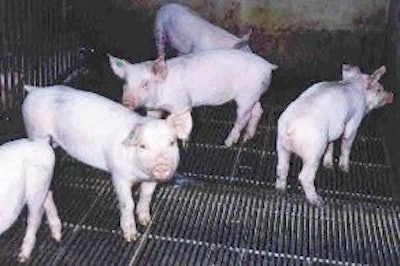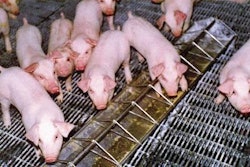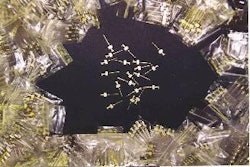
With the approach of winter in the Northern Hemisphere it is time to consider how well piglet-producing herds are protecting themselves against transmissible gastro-enteritis (TGE). The disease is seen more commonly in the winter months. The first priority must be to have top-quality biosecurity measures in place to prevent the causal coronavirus from entering the farm. For those units that do become infected, however, the aim should be to spread the infection around all pigs as quickly as possible in order to promote immunity and reduce the risk of seeing the endemic form of the diseasewhich can often be more damaging economically than the epidemic version.
Epidemic TGE is a highly infectious condition leading to vomiting and/or diarrhoea in pigs of all ages. In acute cases in a naïve herd, the mortality rate among piglets up to 7 days old can reach 100%. The typical piglet deaths from an acute outbreak are 1.5 times the total number of sows in the unit. But the losses decrease rapidly with age, such that deaths are low in pigs over 3 weeks old and rare in pigs aged 6 weeks or more.
Endemic TGE can be a far greater problem and has serious cost implications, especially in large herds, multiple-site systems and one-site production units. A common sequel to the epidemic version, endemic TGE persists as a less acute disease causing a usually grey and pasty scour in pigs over 6 days of age. Mortality is lower than with epidemic TGE, but remains an issue. Significant costs are associated with the slow growth of the affected piglets in farrowing houses and especially in nursery units. Furthermore, damage to the intestinal wall in grow/finish pigs can predispose them to other diseases (such as ileitis and Salmonella).
Spread of infection: The virus is relatively fragile and is susceptible to ultra-violet light, so spread is much more likely in the winter when there is less exposure to sunshine. The prime method of spread is pig to pig. Large amounts of virus are excreted in the faeces of infected pigs. A common way for new infection to enter a farm is through the introduction of subclinically-infected animals. Part of the reason for this is the difficulty diagnosing low-grade endemic TGE. Special care needs to be taken when purchasing breeding stock.
Other methods of transmission are important in closed herds, in production systems and in pig-dense areas. Vehicles pose a major threat in large systems. The virus also can be brought in on the clothing or equipment of people visiting the facility. Dogs, foxes and cats can shed the virus in their faeces for 2-3 weeks. Wild birds can spread the virus mechanically, as can insects.
From a biosecurity and disease control viewpoint, however, TGE is a peculiar disease. As always, the prime target in prevention is to exclude the agent from any pig production system. The fact that the virus is highly infectious makes this is a considerable biosecurity challenge. But there is also the unique situation that, once an outbreak occurs in a breeding herd, we need to spread the disease rapidly around the farm and so encourage immunity to develop in all stock to lessen the chances of endemic TGE developing.
This approach to the control of endemic TGE is based on the knowledge that, once infected, all animals will either die from the disease or will recover and become immune. Assuming all animals on the farm are immune, the virus will only survive in the herd for about 90 days after clinical signs. Provided there are no fresh susceptible pigs introduced, the virus should be eliminated and endemic disease prevented through effective terminal biosecurity.
Why does this method of controlling endemic TGE sometimes fail? Various possibilities arise. Perhaps the virus was not spread throughout the farm or system in the early acute stages. Possibly some non-immune new stock were purchased during the control period. Conceivably, when the maternal antibody protection for piglets from immune sows decreased after weaning this allowed them to be infected by still-present virus, perpetuating viral survival in the nursery.
Another risk factor arises because, unlike with natural infection, the duration of vaccinal immunity is not lifelong. In young pigs vaccination for TGE can be severely compromised by maternal immunity. Also, some pigs are partially immune, possibly related to concurrent infection with the porcine respiratory coronavirus (PRCV). Other pigs may be immuno-compromised by such agents as PRRSV, PCV2 or PRV/ADV.
Just as likely a cause of failure is inadequate terminal biosecurity in the nursery or in grower-finisher barns. Because of this, naïve pigs are re-exposed to virus when they come through from the breeding herd.
Preventing TGE entry: Obviously, it is vital to start by trying to protect the unit from infection by means of stringent external biosecurity practices. TGE virus is susceptible to a range of disinfectants, but any biosecurity programme needs to address all pathogens. Therefore, always use a proven broad-spectrum disinfectant. A product that can be used effectively at lower dilutions gives an increased safety margin. Equally, remember that TGE spreads mainly in the winterso the disinfectant you choose must be active at low temperatures (many are not).
Because the disease most often enters a breeding herd inside new pigs, incoming animals should be from a proven TGE-negative source and isolated in a separate isolation unit for care by non-farm staff, still under high levels of biosecurity. Preferably, isolation should be 60 days. Consider serological testing for TGE prior to moving them to the main farm, but a test differentiating from PRCV will be needed.
Within your stock-proof fence, exclude all non-essential visitors. People are a significant risk factor in the spread of TGE, although good biosecurity measures have been shown to prevent the entry of the virus on personnel. One study demonstrated that people who showered and changed clothing (or washed their hands and changed) did not transmit TGE, whereas those who did not do this transmitted the infection. All personnel entering the unit should ideally shower and change, but as a minimum they must be required to change all outer clothing and boots (and make it a requirement to wear a hat that you supply). At entry to the farm, boots must be cleaned and a foot dip used. This process should be repeated at entry to every building.
On the question of vehicles, it is clear that pig transporters, including their tractor units, must be thoroughly cleaned after each batch hauled. Less obvious, however, is the risk attached to the use of recycled water in the initial cleaning of trucks. Use fresh water, preferably with a heavy-duty detergent in it to facilitate and speed up the process. After the removal of all organic material, apply a broad-spectrum disinfectant known to be active against TGE virus. Post-disinfection drying will enhance virus kill, but it is not a replacement for good initial cleaning and disinfection.
One concern in pig-dense areas is the contamination of vehicles while on the road by other trucks containing pigs. For this reason, keep out all unnecessary vehicles and insist that deliveries are made outside the fence perimeter. Any vehicle needing to enter the farm should pass through a wheel dip at the entrance or preferably be sprayed with a disinfectant. Think similarly about full biosecurity for any equipment which has to enter. Where possible, it should be outer-wrapped and this wrapping removed at entry. Even then the equipment must be thoroughly disinfected.
Against endemic TGE: Breakdowns do occur despite precautions. Fast responses are needed if the infection does enter a system or farm, for control aimed at promoting immunity to stop virus replication and survival. It is essential to spread infection to all pigs as soon as possible. While that is taking place, external biosecurity must be maintained to prevent infection with any other pathogens entering the unit. In this phase, good terminal disinfection of buildings is also necessary in any batch system to prevent infection spreading from one batch to the next. The terminal disinfection would include removing gross contamination, thorough cleaning and then disinfecting. Water and feed systems must also be cleaned and disinfected. Any equipment used in the buildings or site needs similar cleaning and disinfection.

















